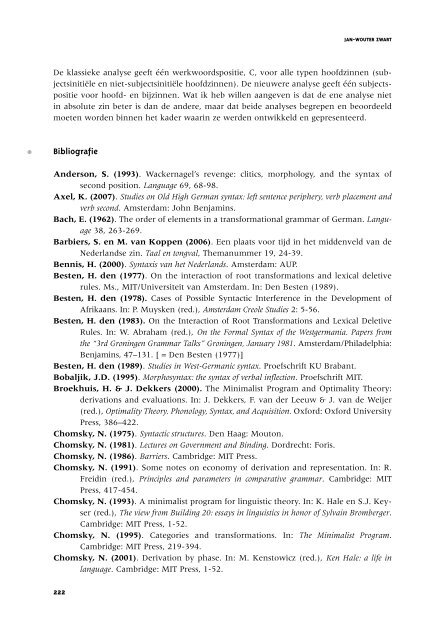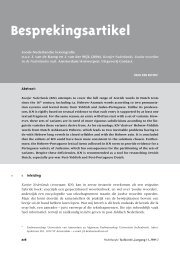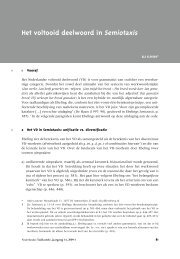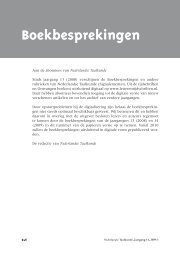Discussie Werkwoord- plaatsing - Nederlandse Taalkunde
Discussie Werkwoord- plaatsing - Nederlandse Taalkunde
Discussie Werkwoord- plaatsing - Nederlandse Taalkunde
Create successful ePaper yourself
Turn your PDF publications into a flip-book with our unique Google optimized e-Paper software.
jan-wouter zwartDe klassieke analyse geeft één werkwoordspositie, C, voor alle typen hoofdzinnen (subjectsinitiëleen niet-subjectsinitiële hoofdzinnen). De nieuwere analyse geeft één subjectspositievoor hoofd- en bijzinnen. Wat ik heb willen aangeven is dat de ene analyse nietin absolute zin beter is dan de andere, maar dat beide analyses begrepen en beoordeeldmoeten worden binnen het kader waarin ze werden ontwikkeld en gepresenteerd.• BibliografieAnderson, S. (1993). Wackernagel’s revenge: clitics, morphology, and the syntax ofsecond position. Language 69, 68-98.Axel, K. (2007). Studies on Old High German syntax: left sentence periphery, verb placement andverb second. Amsterdam: John Benjamins.Bach, E. (1962). The order of elements in a transformational grammar of German. Language38, 263-269.Barbiers, S. en M. van Koppen (2006). Een plaats voor tijd in het middenveld van de<strong>Nederlandse</strong> zin. Taal en tongval, Themanummer 19, 24-39.Bennis, H. (2000). Syntaxis van het Nederlands. Amsterdam: AUP.Besten, H. den (1977). On the interaction of root transformations and lexical deletiverules. Ms., MIT/Universiteit van Amsterdam. In: Den Besten (1989).Besten, H. den (1978). Cases of Possible Syntactic Interference in the Development ofAfrikaans. In: P. Muysken (red.), Amsterdam Creole Studies 2: 5-56.Besten, H. den (1983). On the Interaction of Root Transformations and Lexical DeletiveRules. In: W. Abraham (red.), On the Formal Syntax of the Westgermania. Papers fromthe “3rd Groningen Grammar Talks” Groningen, January 1981. Amster dam/Philadel phia:Benjamins, 47–131. [ = Den Besten (1977)]Besten, H. den (1989). Studies in West-Germanic syntax. Proefschrift KU Brabant.Bobaljik, J.D. (1995). Morphosyntax: the syntax of verbal inflection. Proefschrift MIT.Broekhuis, H. & J. Dekkers (2000). The Minimalist Program and Optimality Theory:derivations and evaluations. In: J. Dekkers, F. van der Leeuw & J. van de Weijer(red.), Optimality Theory. Phonology, Syntax, and Acquisition. Oxford: Oxford UniversityPress, 386–422.Chomsky, N. (1975). Syntactic structures. Den Haag: Mouton.Chomsky, N. (1981). Lectures on Government and Binding. Dordrecht: Foris.Chomsky, N. (1986). Barriers. Cambridge: MIT Press.Chomsky, N. (1991). Some notes on economy of derivation and representation. In: R.Freidin (red.), Principles and parameters in comparative grammar. Cambridge: MITPress, 417-454.Chomsky, N. (1993). A minimalist program for linguistic theory. In: K. Hale en S.J. Keyser(red.), The view from Building 20: essays in linguistics in honor of Sylvain Bromberger.Cambridge: MIT Press, 1-52.Chomsky, N. (1995). Categories and transformations. In: The Minimalist Program.Cambridge: MIT Press, 219-394.Chomsky, N. (2001). Derivation by phase. In: M. Kenstowicz (red.), Ken Hale: a life inlanguage. Cambridge: MIT Press, 1-52.222






